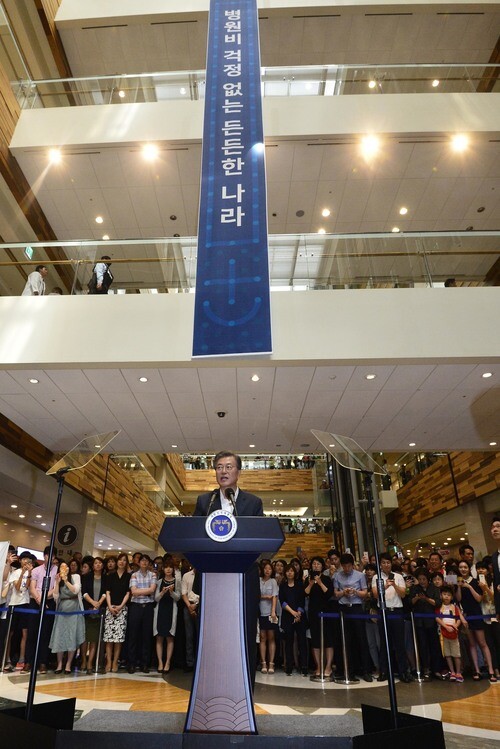hankyoreh
Links to other country sites 다른 나라 사이트 링크
Study finds that 87% of South Korean households have private health insurance

A recent study has found that 87% of South Korean households have various kinds of private insurance policies such as cancer insurance and accident insurance because of the National Health Insurance system’s low rate of coverage, which is slightly above 60%. These households are paying an average of 290,000 won a month (US$266) in premiums.
According to the “2017 Survey of Public Perceptions Toward the Health Insurance System,” released on Dec. 17 by the Health Insurance Policy Research Institute, which is affiliated with the National Health Insurance Corporation (NHIC), 86.9% of households responded that at least one household member is enrolled in private health insurance. This survey was conducted between August and September on 2,000 people around the country between the ages of 20 and 69 who are either enrolled in national health insurance or who are dependents of someone who is.
Of the enrolled respondents, 66.1% were aware of how much they were paying in premiums for private-sector health insurance, with their premiums amounting to an average of 287,000 won per month. More specifically, the largest share, or 52.0%, were paying between 200,000 (US$183) and 500,000 won (US$460) in premiums, followed by 21.3% paying between 100,000 and 200,000 won and 12.9% paying more than 500,000 won. Both the enrollment rate and the cost of the policies are quite high.
“We were able to confirm that the enrollment rate in private health insurance and the level of premiums being paid by households remain high. This means that, even though the national health insurance system is being run for the entire public, the actual burden of medical costs on households has increased, leading to the expansion of supplementary private health insurance,” the researchers said.
83.5% of the households in the survey had “actual cost” health insurance, one of the most popular kinds of private-sector “supplemental” health insurance policy, for which they were paying an average of 147,000 (US$135) won a month in premiums. When these households were asked why they had enrolled, 69.2% said it was to reduce the economic burden on the household resulting from diseases or accidents while 28.4% said it was because they believed that the services guaranteed by national health insurance were inadequate.
When respondents’ characteristics were analyzed, a high enrollment rate in private health insurance was correlated with higher average monthly income and higher national health insurance premiums. In contrast, the enrollment rate was lower in households with less than 2 million won (US$1,830) in monthly income, households including a person with a disability or with a chronic disease, and households that regularly face high bills for medical treatment. This implies that the low coverage rate for national health insurance is causing the polarization of health and medical care.
As of 2015, the coverage rate for national health insurance was just 63.4%. The average rate in the 34 member states of the OECD was 80%. By 2022, the government is planning to spend 30.6 trillion won in an effort to raise the coverage rate to 70%.
By Park Ki-yong, staff reporter
Please direct questions or comments to [english@hani.co.kr]

Editorial・opinion
![[Column] Park Geun-hye déjà vu in Yoon Suk-yeol [Column] Park Geun-hye déjà vu in Yoon Suk-yeol](https://flexible.img.hani.co.kr/flexible/normal/500/300/imgdb/original/2024/0424/651713945113788.jpg) [Column] Park Geun-hye déjà vu in Yoon Suk-yeol
[Column] Park Geun-hye déjà vu in Yoon Suk-yeol![[Editorial] New weight of N. Korea’s nuclear threats makes dialogue all the more urgent [Editorial] New weight of N. Korea’s nuclear threats makes dialogue all the more urgent](https://flexible.img.hani.co.kr/flexible/normal/500/300/imgdb/original/2024/0424/7317139454662664.jpg) [Editorial] New weight of N. Korea’s nuclear threats makes dialogue all the more urgent
[Editorial] New weight of N. Korea’s nuclear threats makes dialogue all the more urgent- [Guest essay] The real reason Korea’s new right wants to dub Rhee a founding father
- [Column] ‘Choson’: Is it time we start referring to N. Korea in its own terms?
- [Editorial] Japan’s rewriting of history with Korea has gone too far
- [Column] The president’s questionable capacity for dialogue
- [Column] Are chaebol firms just pizza pies for families to divvy up as they please?
- [Column] Has Korea, too, crossed the Rubicon on China?
- [Correspondent’s column] In Japan’s alliance with US, echoes of its past alliances with UK
- [Editorial] Does Yoon think the Korean public is wrong?
Most viewed articles
- 1[Guest essay] The real reason Korea’s new right wants to dub Rhee a founding father
- 2Why Korea shouldn’t welcome Japan’s newly beefed up defense cooperation with US
- 3[Column] ‘Choson’: Is it time we start referring to N. Korea in its own terms?
- 4New AI-based translation tools make their way into everyday life in Korea
- 5[Column] Park Geun-hye déjà vu in Yoon Suk-yeol
- 6Senior doctors cut hours, prepare to resign as government refuses to scrap medical reform plan
- 7Opposition calls Yoon’s chief of staff appointment a ‘slap in the face’
- 8Will NewJeans end up collateral damage in internal feud at K-pop juggernaut Hybe?
- 9Terry Anderson, AP reporter who informed world of massacre in Gwangju, dies at 76
- 10Thursday to mark start of resignations by senior doctors amid standoff with government